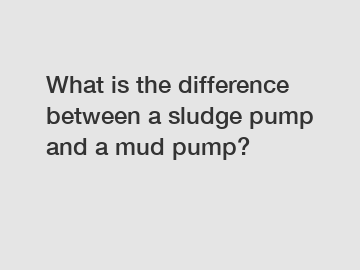What is the difference between a sludge pump and a mud pump?
Sludge Pump and Mud Pump: Understanding the Difference.
What is the difference between a sludge pump and a mud pump? This is a common question among those involved in industries such as construction, mining, and wastewater management. While sludge and mud pumps are both designed to move fluids, there are key differences that set them apart.
The main distinction lies in the types of materials they handle. A sludge pump is specifically designed to handle slurry, which is a semi-liquid mixture of solid particles and water. Sludge typically contains high concentrations of solids, such as sand, silt, and other debris. The purpose of a sludge pump is to extract and transport this thick and viscous material.

On the other hand, a mud pump is primarily used for drilling applications in the oil and gas industry. It is designed to handle drilling mud, a mixture of water, clay, and various chemicals. Drilling mud is used to cool the drill bit, remove drill cuttings, and provide stability to the wellbore during the drilling process. Mud pumps are crucial in maintaining pressure and circulation while drilling, ensuring the efficiency and safety of oil and gas operations.
The fundamental difference between sludge and mud pumps can be traced back to the nature of the materials they handle. Sludge pumps need to be robust and capable of handling abrasive solids without clogging or damage to the pump mechanism. They are often equipped with special features such as a grit-resistant impeller and a reinforced casing.
Mud pumps, on the other hand, require high-pressure capabilities to effectively circulate the drilling mud. This is achieved through the use of reciprocating pistons, which generate the required pressure to push the mud through the wellbore. Mud pumps have to withstand harsh drilling conditions and are built with heavy-duty components to ensure longevity and reliability.
Understanding the difference between sludge and mud pumps is essential for various industries. Using the wrong type of pump can lead to inefficiencies, increased downtime, and potential damage to equipment. For example, using a sludge pump in drilling operations can result in inadequate pressure, reduced drilling speed, and compromised wellbore stability. Likewise, using a mud pump in sludge removal applications may lead to clogging and wear due to the pump's inability to handle the abrasive solids present in slurry.
In conclusion, while both sludge and mud pumps are designed to move fluids, their specific applications and material-handling capabilities differentiate them. Sludge pumps are intended for moving slurry and dealing with high concentrations of solids, while mud pumps are essential in drilling operations to maintain pressure and circulation of drilling mud. Understanding these differences enables industries to choose the appropriate pump for their specific needs, ensuring operational efficiency, reliability, and long-term cost savings.
The company is the world’s best wellhead api 10d ball screw gate valve exporter, 5.5kw mud agitator, elevator links supplier. We are your one-stop shop for all needs. Our staff are highly-specialized and will help you find the product you need.
152
0
0


Comments
All Comments (0)